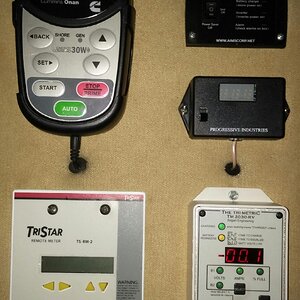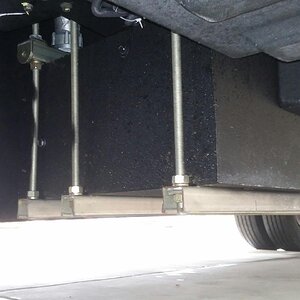Chuggs
RVF Supporter
- Joined
- Nov 3, 2019
- Messages
- 604
- RV Year
- 2016
- RV Make
- Newmar
- RV Model
- Ventana 4037
- RV Length
- 40’
- TOW/TOAD
- Jeep JKU
Late to this party…
O believe the 2016 DS was the first year to have “More Floor”. So, you have HWH hydraulic operated slides…and regrettably, I am not versed in power sources.
Your black bag should have a handout which details the location and designation for all the dc breakers and fuses. This can help identify where your protection would be.
if the controller is amperage triggered, like our electric slide controllers…the motors are shut off when they detect a rise in amp draw…which happens when a motor hits it’s travel limit. If your source voltage is low, from weak batteries, the motors naturally draw more amperage…as the motor consumes watts to do work. This may trick your controller into shutting down early.
The controller monitors your ignition..and if you have it turned in..this defeats the slideouts. As you do NOT want the slides to inadvertently deploy while driving down the highway. Check ignition off.
I would imaging the motors are wired to the house system though.
Your chassis batteries if wired like mine…are direct wired to the engine components. Direct wired to the bi-directional relay (BIM)…but switch wired to the front dash. Look for a big cable going to a disconnect switch…then going to a panel housing two 150A fuses…or circuit breakers on a Sparta. From there the two fuse protected cables go to the compartment under the drivers seat. You will see rather large terminals inside that compartment…which is a great place to use a dc voltage meter to read if you are getting power from the chassis batteries. If the fuse panels have power up there…I believe most of them have little red led lights next to the fuses, which light when a fuse is blown.
The handout is your friend…
Panels will sometimes have stickers with the fuse designations… Chassis fuses are generally in the chassis battery compartment, and in the compartment under the drivers seat…however there are inline fuses added to many of the components, which are scattered around here and there.
House fuses begin in the house battery compartment with the large catastrophic fuses for the positive leads going to the inverter and the house. So you will notice House, Inverter, and bi-directional relay positives coming off the bank. The house is tricky…it goes back to th wall behind the cord reel…hidden behind a velcroed on plastic panel. It is attached to the house disconnect relay controlled by the salesmans switch. You will notice it looks like an octopus…as the side that is directly connected to the battery will be constant battery powered, and is distributed to a fuse panel and certain self resetting thermal dc breakers. The other side of the relay powers disconnect battery powered fuse block and some self resetting thermal dc fuses. These are the circuits that the salesman switch actually disconnect when in the store position. On the fuse block connected to the disconnect side of the relay…two big fuses run power into the half bath to power the dc distribution panel inside the half bath. You will likely notice a sticker inside the half bath which details hat the fuses go to…and likewise, the plastic panel behind the cord reel, if they built it properly, will have a sticker on the back of it detailing what fuses go to what. These are helpful to any technician performing work…and aid the owner too…if they can’t find the handout inside the black bag.
O believe the 2016 DS was the first year to have “More Floor”. So, you have HWH hydraulic operated slides…and regrettably, I am not versed in power sources.
Your black bag should have a handout which details the location and designation for all the dc breakers and fuses. This can help identify where your protection would be.
if the controller is amperage triggered, like our electric slide controllers…the motors are shut off when they detect a rise in amp draw…which happens when a motor hits it’s travel limit. If your source voltage is low, from weak batteries, the motors naturally draw more amperage…as the motor consumes watts to do work. This may trick your controller into shutting down early.
The controller monitors your ignition..and if you have it turned in..this defeats the slideouts. As you do NOT want the slides to inadvertently deploy while driving down the highway. Check ignition off.
I would imaging the motors are wired to the house system though.
Your chassis batteries if wired like mine…are direct wired to the engine components. Direct wired to the bi-directional relay (BIM)…but switch wired to the front dash. Look for a big cable going to a disconnect switch…then going to a panel housing two 150A fuses…or circuit breakers on a Sparta. From there the two fuse protected cables go to the compartment under the drivers seat. You will see rather large terminals inside that compartment…which is a great place to use a dc voltage meter to read if you are getting power from the chassis batteries. If the fuse panels have power up there…I believe most of them have little red led lights next to the fuses, which light when a fuse is blown.
The handout is your friend…
Panels will sometimes have stickers with the fuse designations… Chassis fuses are generally in the chassis battery compartment, and in the compartment under the drivers seat…however there are inline fuses added to many of the components, which are scattered around here and there.
House fuses begin in the house battery compartment with the large catastrophic fuses for the positive leads going to the inverter and the house. So you will notice House, Inverter, and bi-directional relay positives coming off the bank. The house is tricky…it goes back to th wall behind the cord reel…hidden behind a velcroed on plastic panel. It is attached to the house disconnect relay controlled by the salesmans switch. You will notice it looks like an octopus…as the side that is directly connected to the battery will be constant battery powered, and is distributed to a fuse panel and certain self resetting thermal dc breakers. The other side of the relay powers disconnect battery powered fuse block and some self resetting thermal dc fuses. These are the circuits that the salesman switch actually disconnect when in the store position. On the fuse block connected to the disconnect side of the relay…two big fuses run power into the half bath to power the dc distribution panel inside the half bath. You will likely notice a sticker inside the half bath which details hat the fuses go to…and likewise, the plastic panel behind the cord reel, if they built it properly, will have a sticker on the back of it detailing what fuses go to what. These are helpful to any technician performing work…and aid the owner too…if they can’t find the handout inside the black bag.













